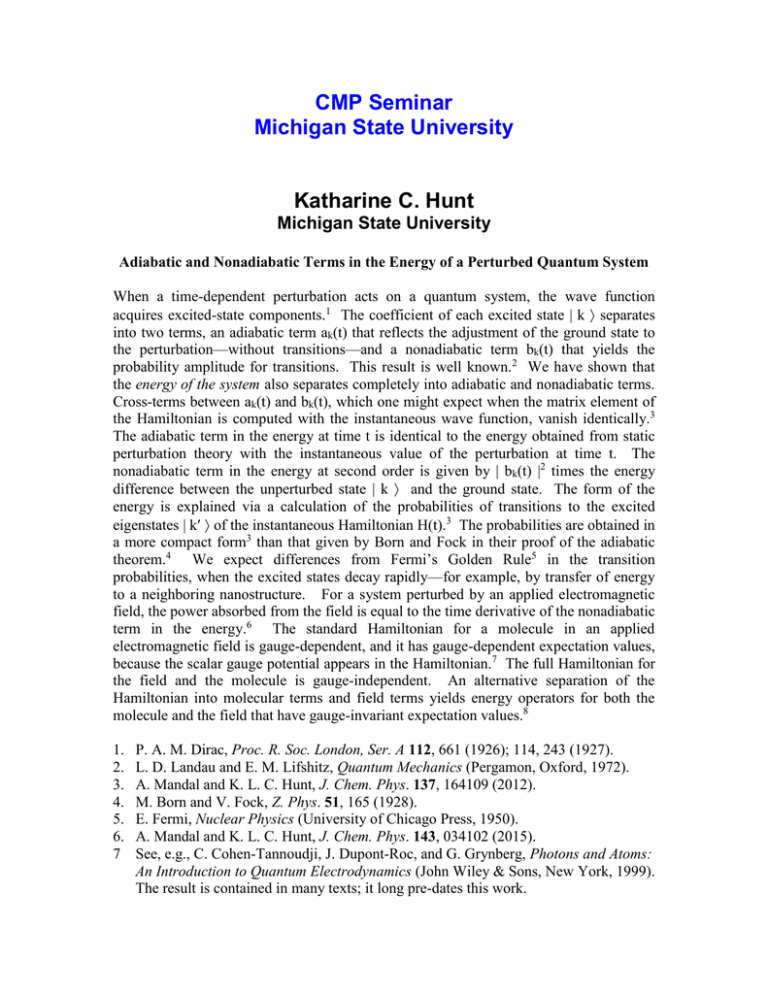Michigan State University Katharine C. Hunt
advertisement

CMP Seminar Michigan State University Katharine C. Hunt Michigan State University Adiabatic and Nonadiabatic Terms in the Energy of a Perturbed Quantum System When a time-dependent perturbation acts on a quantum system, the wave function acquires excited-state components.1 The coefficient of each excited state | k separates into two terms, an adiabatic term ak(t) that reflects the adjustment of the ground state to the perturbation—without transitions—and a nonadiabatic term bk(t) that yields the probability amplitude for transitions. This result is well known.2 We have shown that the energy of the system also separates completely into adiabatic and nonadiabatic terms. Cross-terms between ak(t) and bk(t), which one might expect when the matrix element of the Hamiltonian is computed with the instantaneous wave function, vanish identically.3 The adiabatic term in the energy at time t is identical to the energy obtained from static perturbation theory with the instantaneous value of the perturbation at time t. The nonadiabatic term in the energy at second order is given by | bk(t) |2 times the energy difference between the unperturbed state | k and the ground state. The form of the energy is explained via a calculation of the probabilities of transitions to the excited eigenstates | k of the instantaneous Hamiltonian H(t).3 The probabilities are obtained in a more compact form3 than that given by Born and Fock in their proof of the adiabatic theorem.4 We expect differences from Fermi’s Golden Rule5 in the transition probabilities, when the excited states decay rapidly—for example, by transfer of energy to a neighboring nanostructure. For a system perturbed by an applied electromagnetic field, the power absorbed from the field is equal to the time derivative of the nonadiabatic term in the energy.6 The standard Hamiltonian for a molecule in an applied electromagnetic field is gauge-dependent, and it has gauge-dependent expectation values, because the scalar gauge potential appears in the Hamiltonian.7 The full Hamiltonian for the field and the molecule is gauge-independent. An alternative separation of the Hamiltonian into molecular terms and field terms yields energy operators for both the molecule and the field that have gauge-invariant expectation values.8 1. 2. 3. 4. 5. 6. 7 P. A. M. Dirac, Proc. R. Soc. London, Ser. A 112, 661 (1926); 114, 243 (1927). L. D. Landau and E. M. Lifshitz, Quantum Mechanics (Pergamon, Oxford, 1972). A. Mandal and K. L. C. Hunt, J. Chem. Phys. 137, 164109 (2012). M. Born and V. Fock, Z. Phys. 51, 165 (1928). E. Fermi, Nuclear Physics (University of Chicago Press, 1950). A. Mandal and K. L. C. Hunt, J. Chem. Phys. 143, 034102 (2015). See, e.g., C. Cohen-Tannoudji, J. Dupont-Roc, and G. Grynberg, Photons and Atoms: An Introduction to Quantum Electrodynamics (John Wiley & Sons, New York, 1999). The result is contained in many texts; it long pre-dates this work. 8. A. Mandal and K. L. C. Hunt, J. Chem. Phys. 144, 044109 (2016). Monday, March 28, 2016 4:10 p.m. BPS 1400 Prof. Mark Dyman - Host






